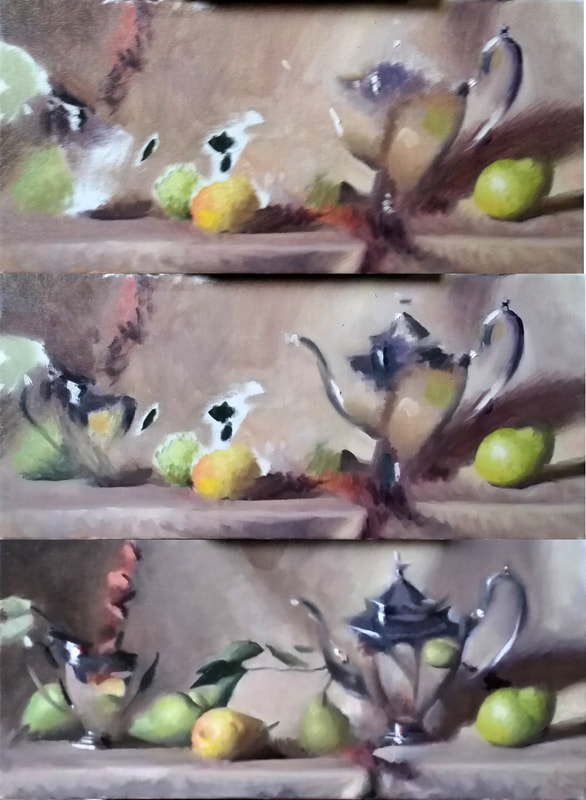|
Some say that direct painting is the easiest type of painting to understand but the hardest to master. It consists merely of painting the right color in the right place. Easy, right? Why didn't I think of that? In my previous blog post on this topic, I shared a bit about technique and why it might matter to know about technique, and then I introduced the idea of Direct Painting, which is my speciality as a member of the Boston School tradition. Some famous practitioners of this method include John Singer Sargent, Zorn, Hakeem Zaria, Velasquez, and of course the masters of the Boston School: Tarbell, Paxton, and Benson. Let me dive in a bit more to what Direct Painting is (for those of you who didn't get to my talk and painting demo). Direct Painting means: No underpainting ("underpainting" basically just means a preliminary sketch in paint on the canvas before getting to the actual colors of the composition) or building up of values or layering of tones -- just directly to the final effects. One of the key phrases masters of Direct Painting have used to describe it is "all the horses at once." This means that the Direct Painter wants all the aspects that he will include in his final painting to be developing simultaneously; not letting any one "horse" get too far ahead. This means the artist must be constantly thinking about all aspects of painting and be constantly evaluating his picture for them. These aspects include form, color (hue, value, and chroma), shape, gesture, edge, sense of light, overall feel, composition, paint quality, depth, atmosphere of form, and anything else he can think of that he wants in his final painting. It is much like juggling -- however, once an artist thinks he has all the balls balanced in the air, sometimes he discovers a new ball! Which is to say: studying a subject so closely can lead to surprising visual revelations, even mid-painting. Direct Painting also requires a sense of detachment and even daring, because a painter will sometimes have to "destroy" previous layers of work in order to incorporate new information and correct old. I find that I can't be hesitant in this approach. Put simply, Direct Painting means that I start with "blobs of color" on my canvas and gradually mold them into my composition, almost like carving into marble. I'm just looking at the colors. This method of painting is in contrast to Indirect Painting, in which painters approach the canvas by first "solving" the shape, composition, and value problems of a painting and then "gluing in" color on top of a brown or gray version of the painting (the "underpainting"). The danger with this method is that it can often sacrifice the live observation of color. My own opinion is that color creates form and that drawing cannot be "solved" without it. As I've come to grasp this method and enjoy it, my obsession with color has only increased and my eyes have been opened to the world of the color spectrum in ways that I simply could not imagine with my previous art training. I've also become a much more efficient painter; whereas I used to take weeks or even months to see a thing and try to get it in front of me on canvas, I can now tackle the same subject matter in literally a matter of hours. There's no time - or pigment - wasted as I make my way to the final result. (For the same reason, Direct Painting is so interesting to share in person, as when I do Live Painting at events). What do you think -- Have you heard of this method before? Is it a technique you could imagine getting into?
8 Comments
12/14/2020 09:57:15 am
Direct painting sounds so nice honestly. The idea that they are constantly evaluating it and thinking makes the art more thrilling. It'd be nice to see them paint live so I can experience their intelligence in person.
Reply
2/23/2022 02:02:14 pm
Paint quality, depth, atmosphere of form, and anything else he can think of that he wants in his final painting, Thank you, amazing post!
Reply
6/22/2022 11:22:29 am
CRM Customer relationship management is a technology for managing all your company's relationships and interactions with customers and potential customers.
Reply
6/22/2022 01:04:20 pm
We, at Databox Solutions, have the capability to build or improve your customer relationship management platform. In fact, we have an adaptable customer management system that will definitely fit into your company’s operations.
Reply
3/22/2023 11:27:07 pm
I found it interesting when you said that shapes and composition would be the first process of creating an indirect painting. My brother informed me a few nights ago that he wants to buy fine art acrylic paintings that he would add to his contemporary painting collection in his studio. He asked if I had opinions on the best option to consider. I appreciate this informative article. I'll tell him we can consult an American artist as they can provide facts about paintings.
Reply
4/14/2023 02:08:36 am
Pretty article! I found some useful information in your blog, it was awesome to read, thanks for sharing this great content to my vision, keep sharing..
Reply
5/25/2023 03:50:04 am
It made sense when you mentioned that an artist should always be thinking about all facets of painting. My friend wants to give her house a new color. I should advise her to hire a painter that is licensed and insured.
Reply
Leave a Reply. |
AuthorHello there, I'm John H. Folley, an oil painter in the Boston School tradition. Thanks for visiting the Beauty Advocacy Blog, where it's my job to help you become a more discerning art appreciator. Connect with John:
Categories
All
Archives
February 2024
|



